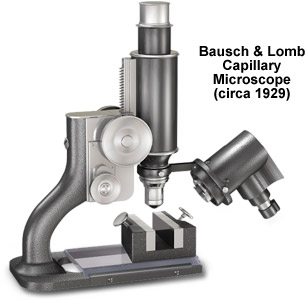Bausch & Lomb Capillary Microscope
Specifically designed to directly examine circulatory activity and structure of minute capillaries beneath skin, the Bausch & Lomb Capillary Microscope was initially constructed in a collaborative effort with several members of the medical research community.

The model featured above was redrawn from photographs of the original microscope, which is part of the Bausch & Lomb microscope collection published in early instrument manuals and catalogs.
In the 1920's, the nail fold along the finger was considered the most suitable area for observing capillary activity. Three distinct features are incorporated into the instrument to facilitate this form of capillary microscopy. Designed to provide plenty of working space, the specimen stage is placed low in relation to the objective. The instrument also includes a finger clamp accompanied by three pairs of rubber pads of varying thickness that can accommodate seven different finger sizes. The clamp is designed to secure a finger into position during examination without constricting circulation. Finally, Bausch & Lomb devised a special illuminating unit that attaches to the objective tube by means of a movable arm.
The lamp is equipped with a 6-volt Mazda bulb and is set behind a high power double lens condenser. Proper lighting can be achieved by tilting the lamp at the most beneficial angle and by using the two filter glasses, green and yellow, which provide sufficient contrast to observe fine details in capillary structure and activity. A standard eyepiece and objective are supplied, however, oculars and objectives possessing higher magnifying powers are required for observing changes in capillary flow. In preparing for capillary microscopy, the finger that is to undergo observation is first cleansed with green soap and water and thinly coated in cedar oil.
BACK TO TWENTIETH CENTURY BAUSCH & LOMB MICROSCOPES
BACK TO TWENTIETH CENTURY MICROSCOPES
